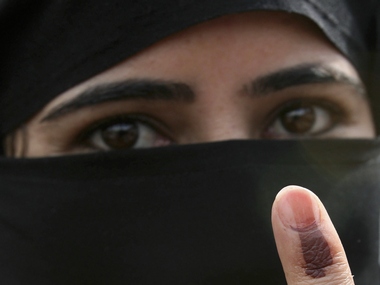Vote bank — what is that exactly? If poll analysts are to be believed, it is a stable, monolithic and homogenous chunk of votes that stays loyal to one political party. When the vote bank shifts, parties lose elections. In our electoral politics, which still relies heavily on mobilising votes along lines of caste and community, the explanation holds good to some extent. Thus experts talk about Muslim votes, Hindu votes, OBC votes, Yadav votes and what not and magic configuration of castes and communities — the rainbow coalition of Mayawati including Dalits and Brahmins; the Muslim-Yadav combination of Lalu Yadav — which work wonders for parties. All pre-election talk is invariably about changing caste and communal equations drawn up by the parties. [caption id=“attachment_181582” align=“alignleft” width=“380” caption=“One of the biggest myths about the community is the community votes as a block. Reuters”]  [/caption] In the very complex electoral politics in the country, such generalisation helps simplify understanding of the process for the outsider. It reduces the whole gamut of intractable issues which influence voter behaviour to an identifiable, explainable something. Why did this party win? Why did the other lose? It is easy to answer away the questions in terms of caste combinations etc. But the problem with this proposition is it treats the individual as an unthinking, unintelligent entity, who does not make independent decisions but follows the herd. It presumes that the individual will sacrifice his free judgement for the collective judgement and that the dominant view in the community decides voting behaviour. But does it really work that way? Evidence shows it does not. Muslims do not vote en bloc as presumed, all members of a single caste don’t vote for one single party and even spouses in one family vote in different ways. The total swing towards one party or against it happens when there’s an emotive issue involving the interests of the whole community. Thus when there’s communal temper running high, entire communities gravitate towards particular parties. However, in normal times the voting behaviour is more scattered. Let’s take the case of Muslims. One of the biggest myths about the community, which has been perpetuated by overstating, is the community votes as a block. According to an article by prominent psephologist Yogendra Yadav, written in the Hindu newspaper, it is not exactly the truth. The article says: The evidence on Muslim voting preference in general elections does not validate the image of Muslims as a ‘vote bank.’ In 2004, the Congress and its allies got 53 percent of the Muslim vote while the BJP and its allies got about 11 percent. The other big vote-getter outside these two was the Samajwadi Party at 16 percent. That is hardly en bloc voting. If we go down to the State level, we find that the Muslim vote tends to consolidate. Still, nowhere near enough to suggest they vote en bloc. Muslims resort to en bloc voting only in states such as Rajasthan, Gujarat, Madhya Pradesh and Delhi when faced with situations of no-choice, when the real competition is between the Congress and the BJP. The Muslim support for the Congress goes down in states such as Andhra Pradesh and Assam, where there is a third option. So does it in Kerala and West Bengal, where the BJP or its allies are not real competitors. In general, the pattern of Muslim voting at the State level is similar to that of a large caste such as the Jats or Brahmins. Coming to castes, all of them have intra-caste hierarchy with several layers separating the top rung from the bottom. The basis of the hierarchical arrangement could be financial strength, ritual position and social standing. Thus we have several categories of Brahmins, with some with best living standards and some worse off than many Dalits. Among the Dalits, too, there are similar arrangements of layers. Thus people in the same caste could have different political opinions, depending where they stand. The truth about Mayawati’s Dalit-Brahmin combo was that, only a section of the Brahmins backed her in 2007, not the entire caste. Nitish Kumar came to power in Bihar by ensuring for himself the votes of the less well-off Yadavs. That’s the normal story in case of all castes. The concept of the vote bank, thus, could be seriously flawed.
The problem with the idea of vote bank is it treats the individual as an unthinking, unintelligent entity, who follows the herd.
Advertisement
End of Article


)
)
)
)
)
)
)
)
)



